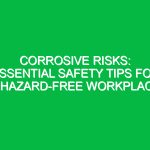Introduction
Hello team! Today, we are gathering for this Toolbox Talk to address a critical issue that affects our health and Safety at work: preventing heart attacks. Heart attacks are not just a personal health concern; they can significantly impact Workplace Safety, productivity, and the overall morale of our team. As we dive into this topic, I encourage you to think about how you can apply these tips in your daily routines and support your colleagues in maintaining a safe working Environment.
Understanding Heart Attacks
To start, let’s understand what a heart attack is. A heart attack, or myocardial infarction, occurs when blood flow to a part of the heart is blocked, typically by a blood clot. This blockage can cause damage to the heart muscle, leading to serious health complications, including death. In the context of our workplace, recognizing the signs and understanding the risks associated with heart attacks are essential for ensuring everyone’s Safety.
Why Heart Attacks Are Relevant in the Workplace
Heart attacks can happen to anyone, regardless of age or health status. In a workplace setting, the consequences of a heart attack can be catastrophic, not only for the individual but also for coworkers and the organization as a whole. Here are some reasons why we need to pay special attention to heart attacks:
- Health Risks: Employees facing high stress, long hours, and sedentary lifestyles are at increased risk.
- Emergency Response: Knowing how to respond in case of a heart attack can save lives.
- Workplace Productivity: Heart attacks can lead to increased absenteeism and reduced productivity.
Who is at Risk?
Identifying individuals at risk is crucial. Factors that can increase the likelihood of a heart attack include:
- Age: The risk increases as you age.
- Family History: A family history of heart disease can predispose individuals.
- Unhealthy Lifestyle: Poor diet, lack of exercise, smoking, and excessive alcohol consumption.
- Chronic Conditions: Conditions such as high blood pressure, diabetes, and high cholesterol.
- Stress: High stress levels can contribute significantly to heart problems.
As we move forward, let’s discuss how we can mitigate these risks effectively.
Recognizing the Symptoms of a Heart Attack
Understanding the symptoms of a heart attack is the first step in Prevention. Common symptoms include:
- Chest Discomfort: This may feel like pressure, squeezing, fullness, or pain.
- Pain in Other Areas: Pain or discomfort may spread to the shoulders, neck, arms, back, teeth, or jaw.
- Shortness of Breath: This may occur with or without chest discomfort.
- Other Signs: Nausea, lightheadedness, or cold sweats.
If you or someone nearby experiences these symptoms, it is crucial to act quickly and seek medical help immediately.
Best Practices for Preventing Heart Attacks in the Workplace
Now that we understand the risks and symptoms, let’s discuss some practical steps we can take to prevent heart attacks in our workplace:
1. Promote a Healthy Lifestyle
Encouraging healthy habits among employees can make a significant difference. Here are a few actionable steps:
- Healthy Eating: Provide access to nutritious meals and snacks in the workplace.
- Regular Exercise: Encourage physical activity, whether through organized group workouts or simple stretches during breaks.
- Smoking Cessation Programs: Offer support and resources for employees looking to quit smoking.
2. Manage Stress Effectively
Stress management is essential for heart health. Consider implementing the following:
- Mindfulness Training: Introduce mindfulness or meditation sessions to help reduce stress levels.
- Flexible Work Hours: Allow employees to adjust their schedules to manage workload and personal commitments better.
- Open Communication: Foster an environment where employees feel comfortable discussing their stressors and mental health.
3. Regular Health Screenings
Encourage regular health check-ups to monitor risk factors such as blood pressure, cholesterol levels, and glucose levels. You can organize annual health fairs or collaborate with local health providers to facilitate these screenings.
Emergency Response Procedures
In the unfortunate event that a heart attack occurs in the workplace, knowing how to respond can save lives. Here’s a simple action plan:
1. Recognize the Signs
Be vigilant about recognizing the signs of a heart attack in yourself and others. If you notice any symptoms, do not hesitate to act.
2. Call for Help
Immediately call emergency services if you suspect someone is having a heart attack. Provide clear information about the location and the condition of the person affected.
3. Provide First Aid
If you are trained, administer first aid. This may include CPR or using an Automated External Defibrillator (AED) if available. Ensure that first aid kits are accessible in the workplace, and consider offering training sessions for employees.
Creating a Safety Culture
A strong safety culture is vital in preventing heart attacks and other health issues in the workplace. Encourage every team member to take ownership of their health and that of their colleagues. Here’s how:
- Encourage Open Dialogue: Foster an environment where everyone feels comfortable discussing health issues.
- Recognize and Support: Acknowledge employees who take steps to improve their health and well-being.
- Set an Example: Leaders should model healthy behaviors to encourage others to follow suit.
Regulations and Standards Related to Heart Attacks
It’s important to be aware of the Regulations and standards that govern health and safety in the workplace. This not only ensures compliance but also fosters a culture of safety. Employers are responsible for providing a safe work environment, which includes addressing potential health risks such as heart attacks.
Some relevant regulations may include:
- Occupational Safety and Health Administration (OSHA): Ensures safe working conditions and provides guidelines for health standards.
- Americans with Disabilities Act (ADA): Protects employees with medical conditions, including heart disease.
Compliance with these regulations not only fulfills legal obligations but also demonstrates a commitment to employee health and safety.
Conclusion
In conclusion, preventing heart attacks in the workplace is a collective responsibility that requires awareness, education, and action. By understanding the risks, recognizing the symptoms, and promoting a culture of health and safety, we can protect ourselves and our colleagues. Remember, a healthy workplace is a productive workplace.
Thank you all for your attention today. Let’s take these insights to heart and work together to create a safer, healthier work environment. If you have any questions or suggestions, please feel free to share them. Together, we can make a difference!


